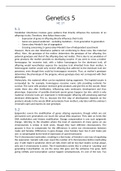Genetics 5
HC 17
5.1
Mendelian inheritance involves gene patterns that directly influence the outcome of an
offspring’s traits. Therefore, they follow these rules:
- Expression of genes in offspring directly influences their traits
- Genes are passed unaltered – excluding mutations – from generation to generation
- Genes obey Mendel’s law of segregation
- Crossing concerning 2+ genes obey Mendel’s law of independent assortment
However, there are also inheritance patterns not conforming to these rules, like maternal
effect. Here, the genotype of the mother determines the genotype of her offspring, the
paternal genotype and that of the offspring does not matter. This is due to accumulation of
gene products the mother provides to developing oocytes. If you were to cross a mother
homozygous for recessive trait, with a father homozygous for the dominant trait, all
offspring would nevertheless express the recessive trait inherited from their mother. A
heterozygote mother would only receive offspring that adhered to the dominant trait she
possesses, even though they could by homozygous recessive. Thus, as mother’s genotype
determines the phenotype of the progeny, whose genotype does not correspond with their
phenotype.
Molecularly, the maternal effect can be explained during oogenesis. The haploid oocyte is
surrounded by, for example, homozygous recessive nurse cells providing nutrients for
survival. The nurse cells produce recessive gene products and give this to the oocyte; these
reside there also after fertilisation, influencing early embryonic development and thus
phenotype. Expression of possible dominant sperm genes happens too late, which is why
maternal recessive traits are expressed in heterozygote offspring still possessing paternal
dominant alleles/genes. This so, because the first step of development depends on the
products already in the oocyte (RNA and proteins from mother), only later will the embryo’s
chromatin open and express its own genotype.
5.2
Epigenetics covers the modification of genes altering expression, though which are not
permanent over generations nor touch the actual DNA sequence. They take on forms like
DNA methylation and histone modification. Dosage compensation is one such epigenetic
change, referring to the situation where the level of expression of many genes on sex
chromosomes is similar in both sexes, though they have different chromosomes. The
purpose is thus to compensate for the differences in active sex chromosomes between
males and females. Differences in gene dosage, since females have two X and males just
one, is compensated by the level of expression of said chromosome.
The X-chromosome inactivation, resulting in a Barr body, of females is one way of equalizing
the expression. Somatic cells even count the number of X chromosomes before inactivating
any; if with triple X syndrome, there are XXX, there will be two Barr bodies so that always
only one X chromosome is active. The X-inactivation centre (Xic) is critical in ‘counting’ and
generating X-inactivation. As are the sense Xist gene and the antisense Tsix gene, both
giving ncRNAs and transcription cannot happen simultaneously, it’s one of the two. Tsix






